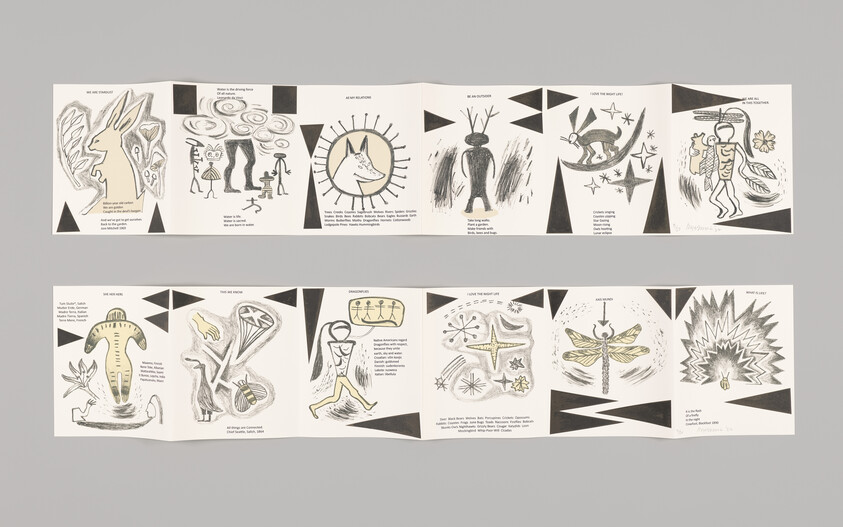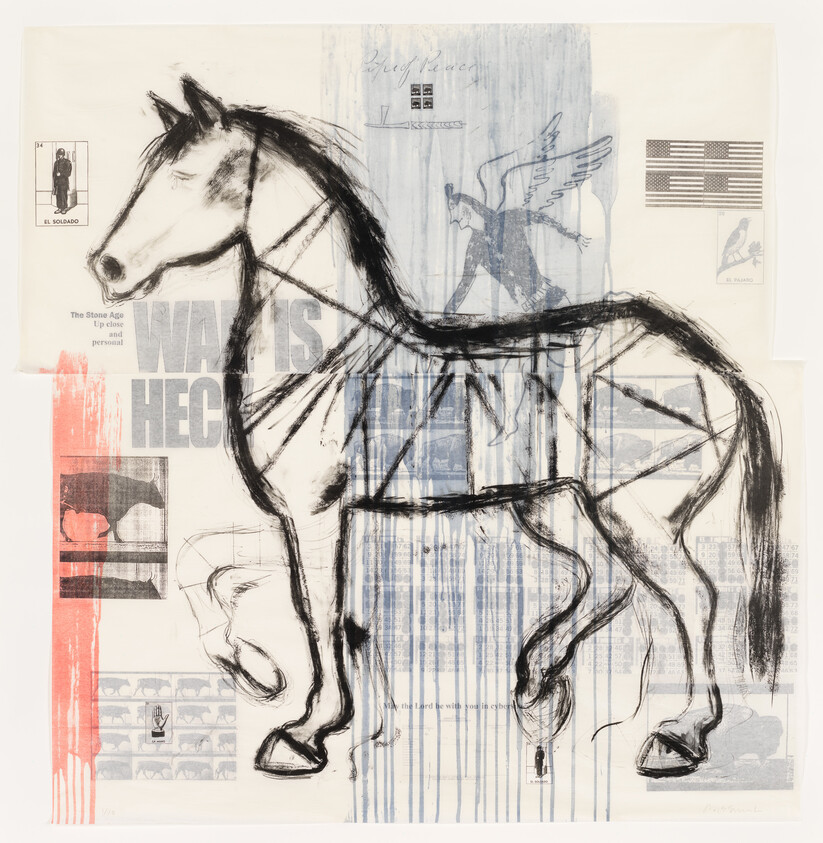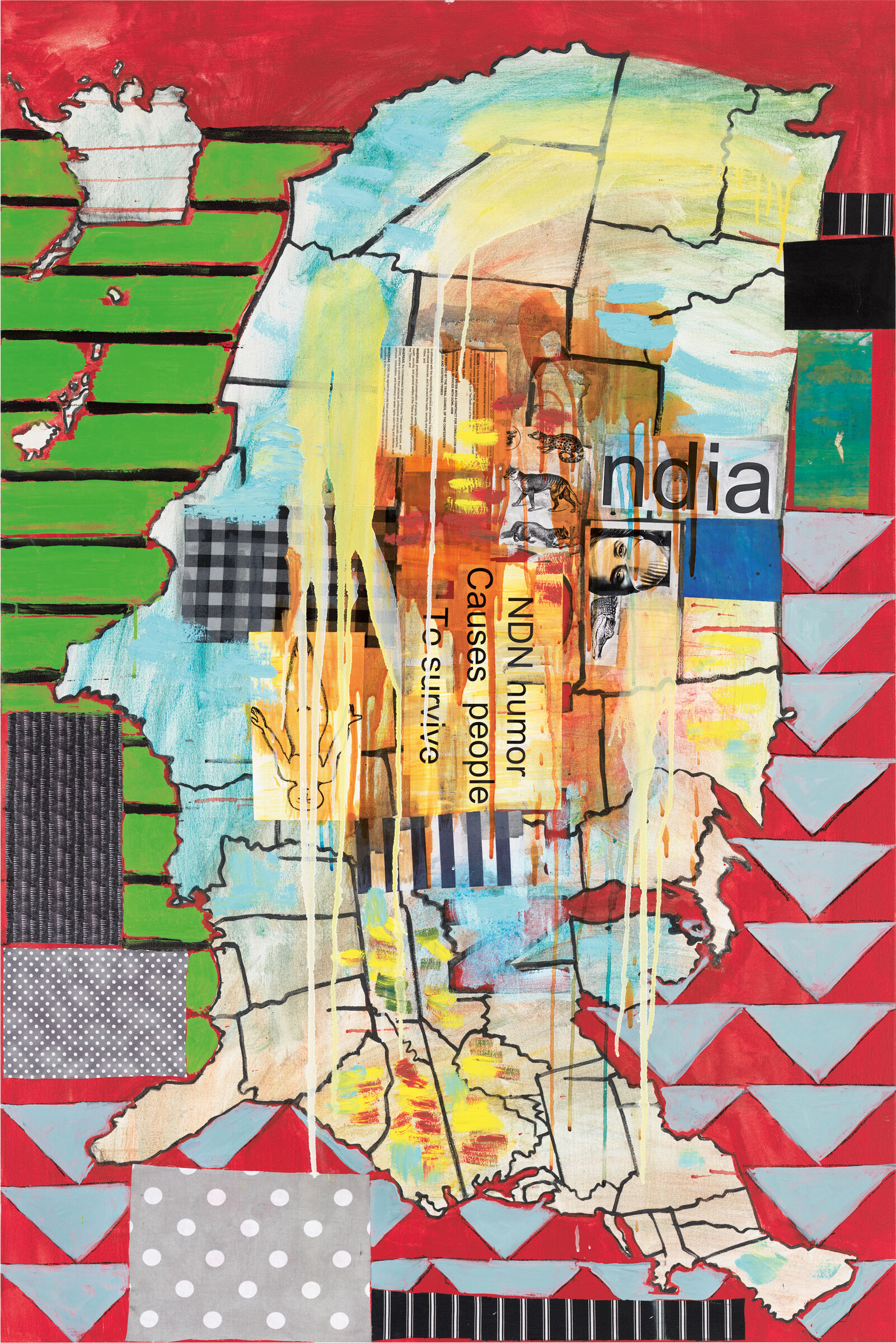Verbal Description: Introduction
Apr 5, 2023
0:00
Verbal Description: Introduction
0:00
Narrator: When you exit the elevators, you will be confronted by two walls offset from the center. To the right is a darker painted wall with the Josh Kline exhibition information, and to the left is a soft white wall with a large painting by Jaune Quick-to-See Smith, as well as the introductory information for the exhibition. This retrospective exhibition’s full title is Jaune Quick-to-See Smith: Memory Map, and the large artwork featured alongside the information is Trade Canoe: Forty Days and Forty Nights, 2015. This piece spans three separate canvases which have all been connected; the two on the left and right are oriented horizontally, and the one in the middle is oriented vertically. The work measures sixty inches tall by one hundred inches long, and through various mediums, depicts a scene of a canoe filled up with many items and creatures, including flying skeletons with feathery wings, a buck head, a snake, a rabbit, a crying eye, and most notably, a tall, dark coyote figure oriented just right of center. This painting will have caution strips on the floor in front of it.
This first gallery space revolves around a large sculpture entitled Indian Madonna Enthroned, 1974, which is situated on a eight inch tall platform in the middle of the space. This sculpture depicts a human figure sitting sideways on a wooden chair: an American flag lies across her lap, a picture frame encases her face, and an ear of corn sits in the place of her heart. In one of her hands is a book titled God Is Red. The cradleboard on her back supports her baby, whose body is made out of sheepskin and whose face is also encased in a picture frame. This sculpture measures 52 inches by 34 inches by 20 inches. On either side of this sculpture against the wall are two works, Ronan Robe #2, 1977 and Ronan Robe #4, 1977. The Ronan Robe works include lodgepoles, or poles of pine, leaning against canvas hangings on the walls of the gallery. A strip of friction tape precedes them, but they are not secured to the wall, so please navigate around the perimeter of the room with care.
The exhibition was designed in collaboration with the artist to prioritize collectivity and a connection to outdoor spaces, informed by the artist’s own Native American ideology and values. With that in mind, the exhibition was designed not as a series of discrete galleries, but as one diffuse space where the placement of works on view are not predetermined by strict chronology or thematic elements, but a mix of both strategies. Open corners, offset walls, and large entryways between galleries encourage a cyclical and cross-pollinated approach to viewing and interacting with the work.
The center of the exhibition is a sort of segmented hallway created between the north and south sides of the whole exhibition space by the offset entrances to the galleries. Each section of wall is accented by a monumental painting, ferrying the visitor toward the wall of windows on the south side of the fifth floor. Throughout this exhibition, visitors are encouraged to reflect on their own position and the connective relationship to nature and the outdoors.
Throughout the galleries, you will find opportunities to commune with other visitors: large openings to each space and custom furniture designed to encourage conversation allow for a variety of ways to enjoy and be present in the galleries.
The first gallery space with Indian Madonna Enthroned is oriented around the earliest works of Smith’s career. The gallery opens at a forty-five degree angle into the larger exhibition space. It is not necessary, but if you would like to follow the narrative curatorial thread, you should proceed to the right after encountering Tongass Trade Canoe and work down the south side of the galleries first.
If this is the route you choose to take, you will find yourself first in the gallery containing some of Smith’s earliest maps and activism. You are invited to sit on the benches situated in the middle of this room. Moving east, the next space is focused on the early environmentalism of Smith’s Chief Seattle series, a slightly smaller gallery space. This opens into the large fourth room, featuring works made around the Columbian quincentenary. The large space has generous communal seating in the middle. The next space is oriented around the themes of imperialism and colonialism, and includes a number of works that the artist made in critique of war. If you continue east, you will find a large wall of windows, a few couches where you are invited to sit and view a cast bronze sculpture of a coyote head tilted Urban Trickster, 2021. If you loop around back toward the northside of the galleries, you’ll find yourself in a room focused on the theme of American capitalism and consumerism. In the center of this gallery, a pinewood lath and synthetic sinew canoe sculpture, titled Trade Canoe: Making Medicine, 2018, hangs suspended from the ceiling. A five inch tall platform sits below it on the ground. Continuing through the rest of the northwest galleries, you will experience two galleries subdivided by a floating wall. These spaces address the importance of Indigenous traditions and the leadership of Native American women. On the west side of the floating wall, a motorized, animatronic sculpture, titled Warrior for the 21st Century, periodically dances, moving up and down from the floor. You can find a full audio description for this piece on our mobile guide. The final gallery in this route returns to the idea of mapping with a focus on depictions of the U.S. map, and also has a view of the first gallery space with the earliest maps that were encountered in the beginning of this path. This vantage articulates the cyclical and overarching ideas that guide this exhibition.
The final gallery with work by Jaune Quick-to-See Smith on this floor is the Kaufman Gallery that can be accessed through the hallway that leads north. In the corridors as you approach the final gallery are drawings on paper, as well as a documentary video and some ephemera related to Smith’s curatorial organizing. There is a bench in this space to make watching the twenty-five minute video more comfortable. The final gallery in Kaufman is centered around the future and the environment.
It is important to note that moving south and looping around to the north is not a prescription for how you should navigate through the space. You are welcome to meander in and around through the offset entryways and exits to each gallery space. It is also important to note that while the primary exhibition is on the fifth and third floors, work by Jaune Quick-to-See Smith is also sprinkled throughout the Museum: including coyote drawings and paintings on the lower level floor with coat check, to the hallways on the sixth and seventh floor, and a coyote sculpture on the outdoor terrace on the eighth floor.



